24-hour Analog Dial on:
[Wikipedia]
[Google]
[Amazon]
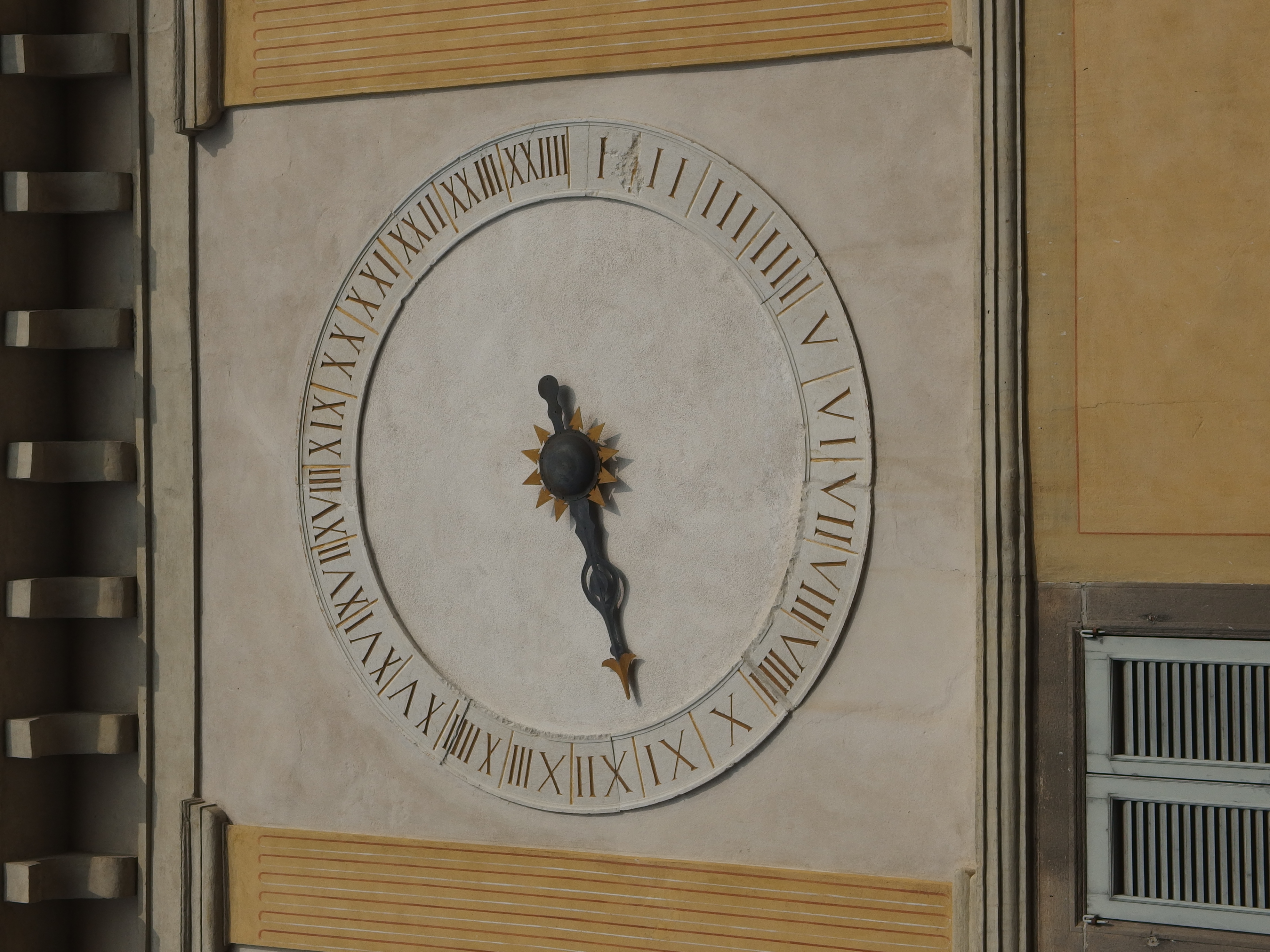
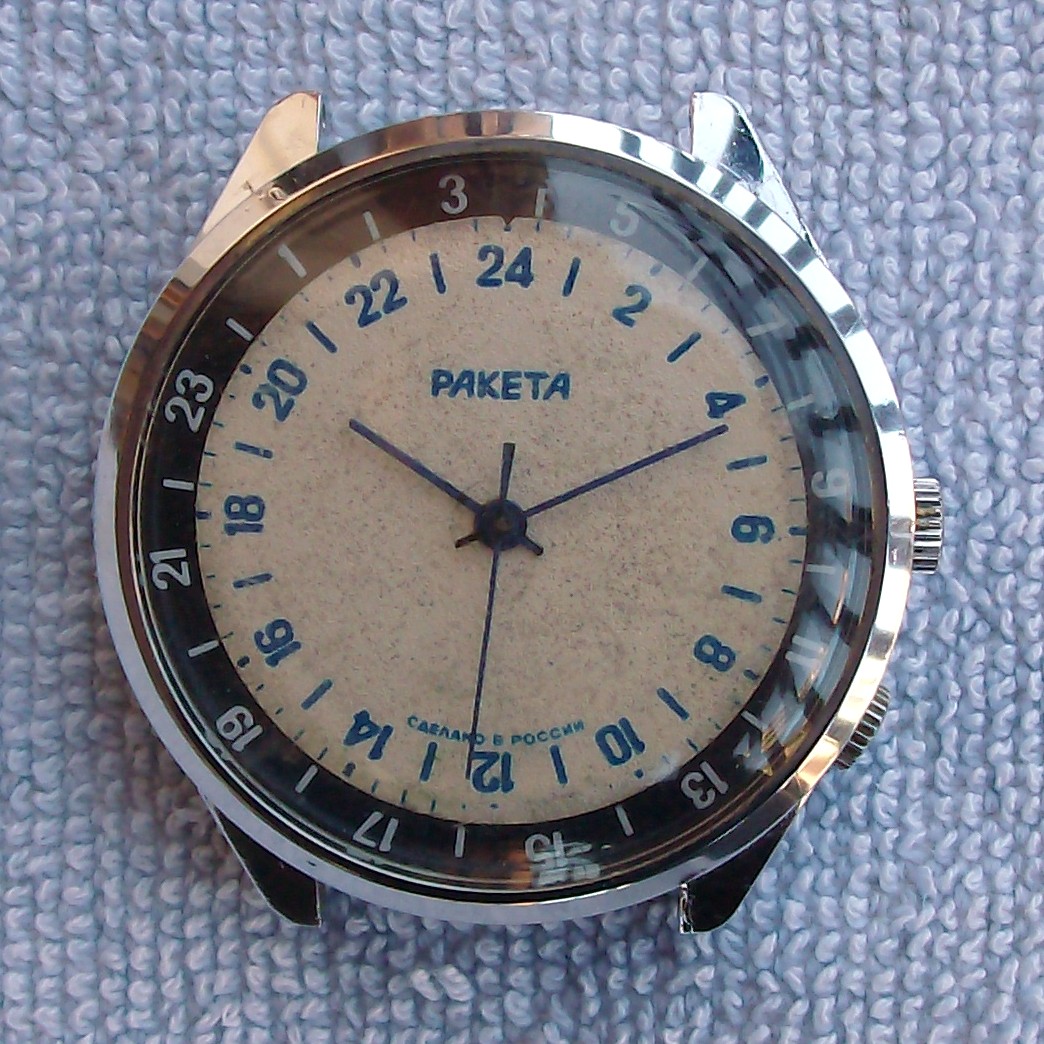

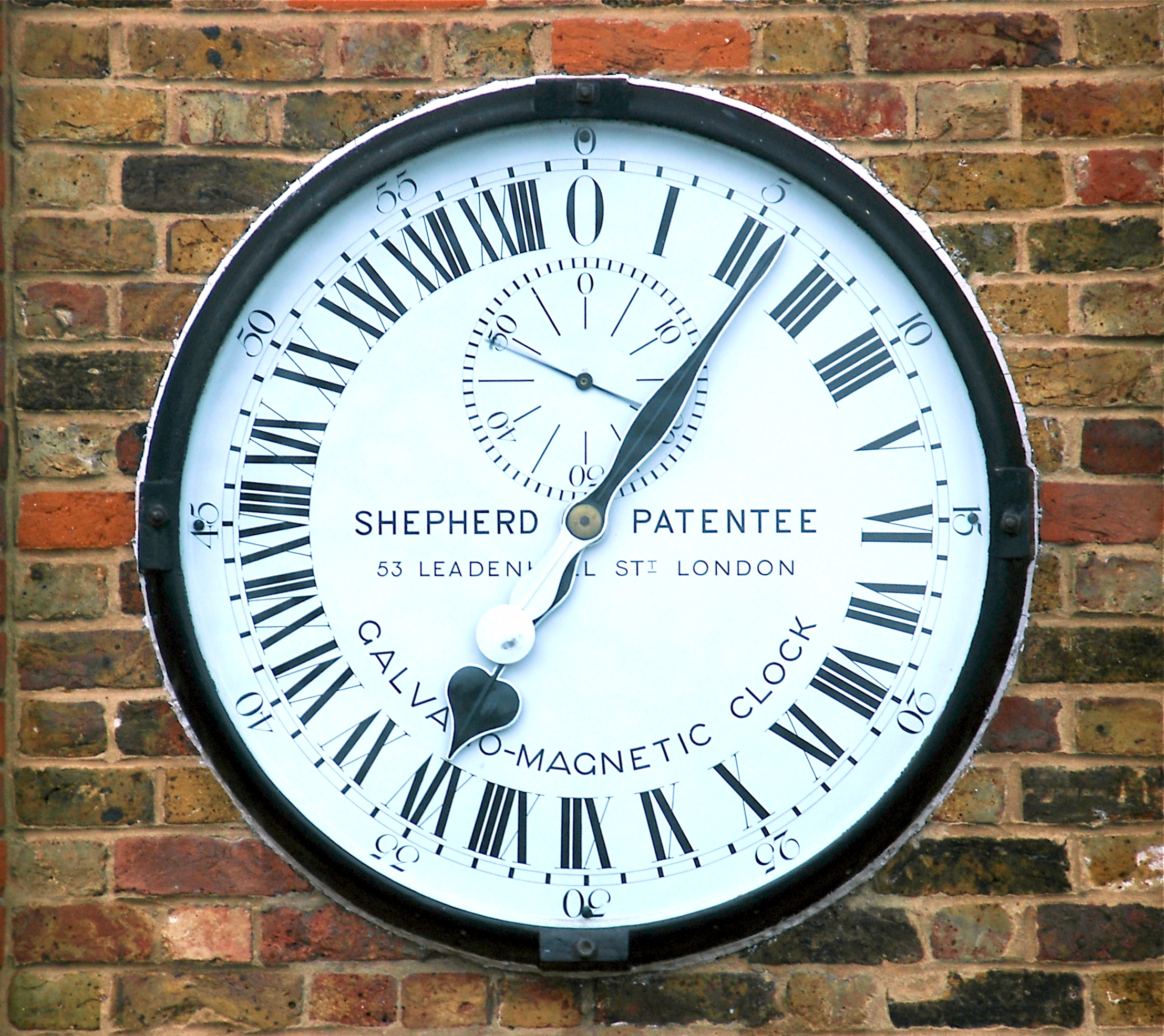

 Clocks and watches with a 24-hour analog dial have an
Clocks and watches with a 24-hour analog dial have an
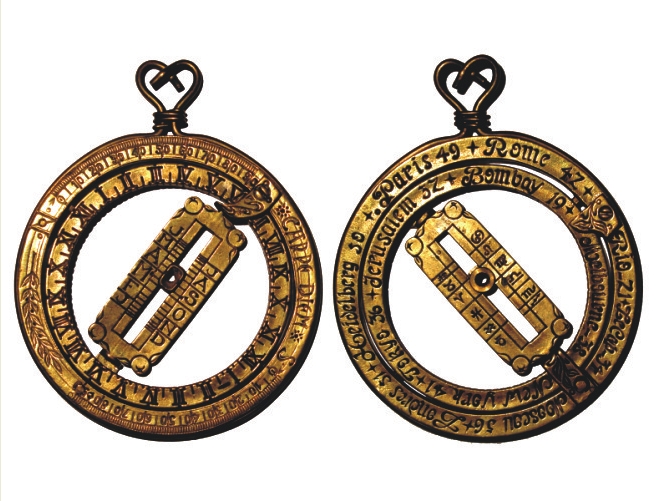 Sundials use some or all of the 24-hour dial, because they show the position of the sun in the sky. Sometimes, for aesthetic rather than practical reasons, all the 24 hour marks are shown.
Medieval clocks often used the 24-hour analog dial, influenced by the widespread example of the
Sundials use some or all of the 24-hour dial, because they show the position of the sun in the sky. Sometimes, for aesthetic rather than practical reasons, all the 24 hour marks are shown.
Medieval clocks often used the 24-hour analog dial, influenced by the widespread example of the
Image:Glycine_Airman_I.jpg, Glycine Airman
Image:Swatch24hourwatch.jpg, Swatch 24-hour watch
Image:Hamilton.jpg, 24-hour chronograph by Hamilton
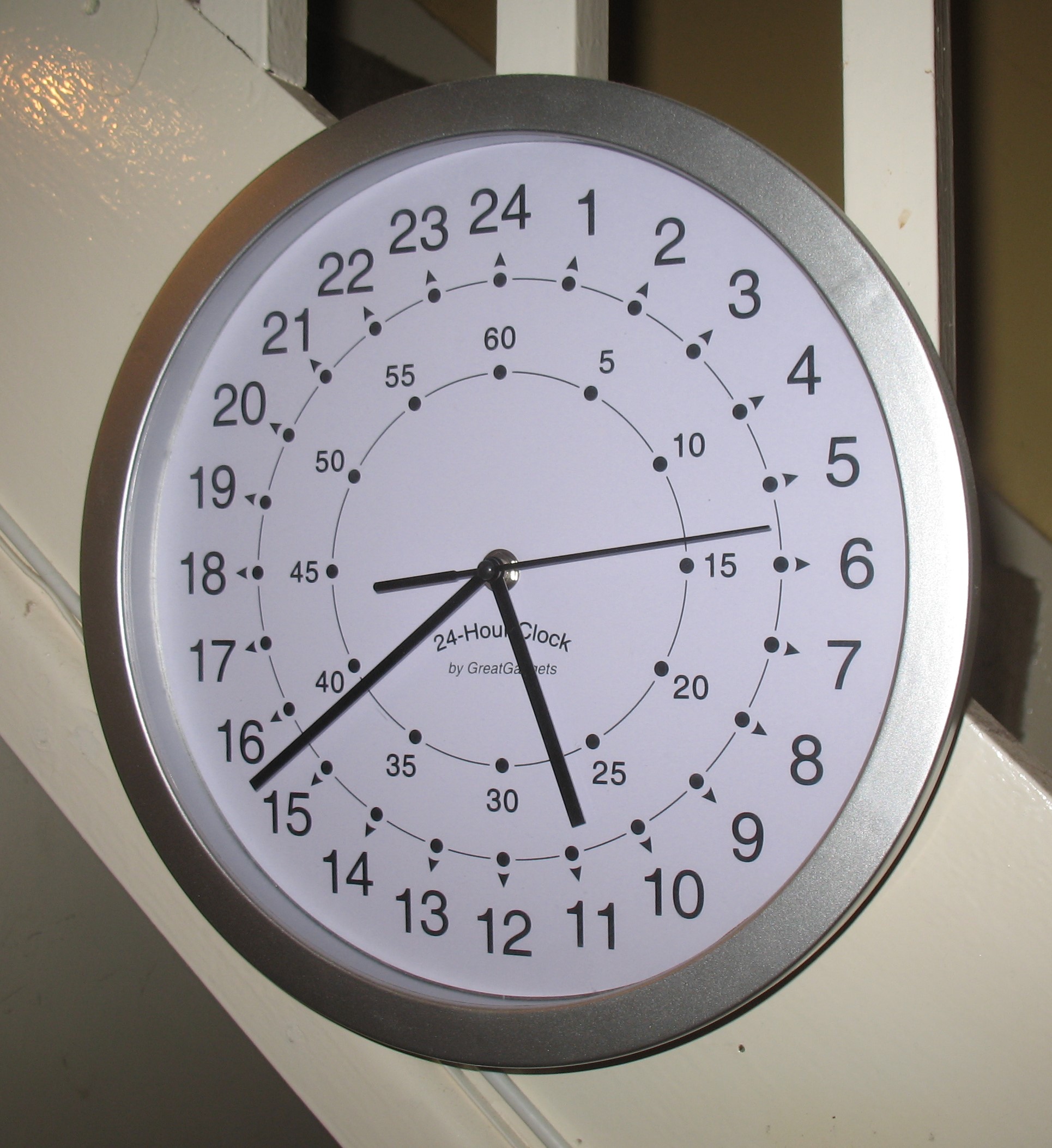
 The major variation in the design of 24-hour analog dials is the location of midnight and noon. Although always opposite each other, 180° apart, noon is sometimes at the top, sometimes at the bottom. A few rare variants place noon and midnight at the right and left sides. There is no ambiguity if the 24-hour numbering is used.
In the United States, the government and military commonly use 24-hour clocks having noon at the bottom; the variant with noon at the top is far less common.
The major variation in the design of 24-hour analog dials is the location of midnight and noon. Although always opposite each other, 180° apart, noon is sometimes at the top, sometimes at the bottom. A few rare variants place noon and midnight at the right and left sides. There is no ambiguity if the 24-hour numbering is used.
In the United States, the government and military commonly use 24-hour clocks having noon at the bottom; the variant with noon at the top is far less common.
 A 24-hour watch is a type of watch with an hour hand that completes a revolution every 24 hours.
The face may be arranged in either of two ways: with noon at the top and midnight at the bottom (similar to how one might observe the passage of the Sun over their time zone whilst facing south), or else rotated 180° with midnight at the top and noon at the bottom (as pictured).
Multiple time zones can be displayed by having multiple hour hands or a rotating bezel. The bezel is a ring around the outside of the watch's face. When it is used, the top of the watch always represents midnight (or noon) GMT. The bezel, which also has hour markings, is then rotated so that its numbering represents local time. So, a pilot always has GMT time available for talking to air traffic control and, when they land, only has to rotate the bezel to "set" the watch to their new local time. Glycine was the first to feature a 24-hour rotating bezel in 1953 with the Airman No.1
A 24-hour watch is a type of watch with an hour hand that completes a revolution every 24 hours.
The face may be arranged in either of two ways: with noon at the top and midnight at the bottom (similar to how one might observe the passage of the Sun over their time zone whilst facing south), or else rotated 180° with midnight at the top and noon at the bottom (as pictured).
Multiple time zones can be displayed by having multiple hour hands or a rotating bezel. The bezel is a ring around the outside of the watch's face. When it is used, the top of the watch always represents midnight (or noon) GMT. The bezel, which also has hour markings, is then rotated so that its numbering represents local time. So, a pilot always has GMT time available for talking to air traffic control and, when they land, only has to rotate the bezel to "set" the watch to their new local time. Glycine was the first to feature a 24-hour rotating bezel in 1953 with the Airman No.1
 A common use for the 24-hour analog method of representing time is for showing the way the time of day depends on one's location. A globe, map, or disk can be used.
A common use for the 24-hour analog method of representing time is for showing the way the time of day depends on one's location. A globe, map, or disk can be used.




 Clocks and watches with a 24-hour analog dial have an
Clocks and watches with a 24-hour analog dial have an hour
An hour (symbol: h; also abbreviated hr) is a unit of time conventionally reckoned as of a day and scientifically reckoned between 3,599 and 3,601 seconds, depending on the speed of Earth's rotation. There are 60 minutes in an hour, and 24 ho ...
hand that makes one complete revolution, 360°, in a day
A day is the time period of a full rotation of the Earth with respect to the Sun. On average, this is 24 hours, 1440 minutes, or 86,400 seconds. In everyday life, the word "day" often refers to a solar day, which is the length between two so ...
(24 hours per revolution). The more familiar 12-hour analog dial has an hour hand that makes two complete revolutions in a day (12 hours per revolution).
Twenty-four-hour analog clocks and watches are used today by logistics workers, fire fighters, police officers, paramedics, nurses, pilots, scientists, and the military, and are sometimes preferred because of the unambiguous representation of a whole day at a time. Note that this definition refers to the use of a complete circular dial to represent a 24-hour day. Using the numbers from 0 to 23 (or 1 to 24) to mark the day is the '' 24-hour clock system''.
Sundials use 24-hour analog dials—the shadow traces a path that repeats approximately once per day.
Many sundials are marked with the double-XII or double-12 system, in which the numbers I to XII (or 1 to 12) are used twice, once for the morning hours, and once for the afternoon and evening hours. So VI (or 6) appears twice on many dials, once near sunrise and once near sunset.
Modern 24-hour analog dials—other than sundials—are almost always marked with 24 numbers or hour marks around the edge, using the 24-hour clock system. These dials do not need to indicate AM or PM.
History
The ancient Egyptians divided the day into 24 hours. There are diagrams of circles divided into 24 sections in the astronomical ceiling in the tomb of Senemut. Sundials use some or all of the 24-hour dial, because they show the position of the sun in the sky. Sometimes, for aesthetic rather than practical reasons, all the 24 hour marks are shown.
Medieval clocks often used the 24-hour analog dial, influenced by the widespread example of the
Sundials use some or all of the 24-hour dial, because they show the position of the sun in the sky. Sometimes, for aesthetic rather than practical reasons, all the 24 hour marks are shown.
Medieval clocks often used the 24-hour analog dial, influenced by the widespread example of the astrolabe
An astrolabe ( grc, ἀστρολάβος ; ar, ٱلأَسْطُرلاب ; persian, ستارهیاب ) is an ancient astronomical instrument that was a handheld model of the universe. Its various functions also make it an elaborate inclin ...
.Geared to the Stars: The Evolution of Planetariums, Orreries, and Astronomical Clocks, Henry C King, University of Toronto Press; (1978) In Northern Europe, the double-XII system was preferred: two sets of the Roman numerals
Roman numerals are a numeral system that originated in ancient Rome and remained the usual way of writing numbers throughout Europe well into the Late Middle Ages. Numbers are written with combinations of letters from the Latin alphabet, eac ...
I to XII were used, one on the left side for the night and morning hours, and another set on the right side of the dial to represent the afternoon and evening hours. In Italy, the numbers from 1 to 24 (I to XXIV in Roman numerals) were used, leading to the widespread use of the 24-hour system in that country. On Italian clocks, though, the I was often shown at the right side of the dial, rather than the top. This probably reflects the influence of the Italian timekeeping system, which started counting the hours of the day at sunset or twilight.
In northern Europe, the double XII system was gradually superseded during the 14th and 15th centuries by the single XII (12-hour system), leading to the widespread adoption of the 12-hour dial for popular use. The 24-hour analog dial continued to be used, but primarily by technicians, astronomers, scientists, and clockmakers. John Harrison, Thomas Tompion, and Mudge Mudge is a surname. Notable people with the surname include:
Politics
* Dirk Mudge (1928–2020), Namibian politician
* Geoffrey Mudge, English politician
Religion
* Enoch Mudge (1776–1850), first Methodist minister reared in New England
* ...
built a number of clocks with 24-hour analog dials, particularly when building astronomical and nautical instruments. 24-hour dials were also used on sidereal clocks.
The famous Big Ben
Big Ben is the nickname for the Great Bell of the Great Clock of Westminster, at the north end of the Palace of Westminster in London, England, and the name is frequently extended to refer also to the clock and the clock tower. The officia ...
clock in London has a 24-hour dial as part of the mechanism, although it is not visible from the outside.
In the 20th century, the 24-hour analog dial was adopted by radio amateurs, pilots, submariners, and for military use.
Today
24-hour analog watches and clocks are still being manufactured today, and are sought after by collectors and enthusiasts. Manufacturers who make 24-hour analog watches include Glycine, Raketa, Vostok,Fortis
Fortis may refer to:
Business
* Fortis AG, a Swiss watch company
* Fortis Films, an American film and television production company founded by actress and producer Sandra Bullock
* Fortis Healthcare, a chain of hospitals in India
* Fortis Inc ...
, Poljot, Swatch, and many others.
Design

 The major variation in the design of 24-hour analog dials is the location of midnight and noon. Although always opposite each other, 180° apart, noon is sometimes at the top, sometimes at the bottom. A few rare variants place noon and midnight at the right and left sides. There is no ambiguity if the 24-hour numbering is used.
In the United States, the government and military commonly use 24-hour clocks having noon at the bottom; the variant with noon at the top is far less common.
The major variation in the design of 24-hour analog dials is the location of midnight and noon. Although always opposite each other, 180° apart, noon is sometimes at the top, sometimes at the bottom. A few rare variants place noon and midnight at the right and left sides. There is no ambiguity if the 24-hour numbering is used.
In the United States, the government and military commonly use 24-hour clocks having noon at the bottom; the variant with noon at the top is far less common.
Watches
 A 24-hour watch is a type of watch with an hour hand that completes a revolution every 24 hours.
The face may be arranged in either of two ways: with noon at the top and midnight at the bottom (similar to how one might observe the passage of the Sun over their time zone whilst facing south), or else rotated 180° with midnight at the top and noon at the bottom (as pictured).
Multiple time zones can be displayed by having multiple hour hands or a rotating bezel. The bezel is a ring around the outside of the watch's face. When it is used, the top of the watch always represents midnight (or noon) GMT. The bezel, which also has hour markings, is then rotated so that its numbering represents local time. So, a pilot always has GMT time available for talking to air traffic control and, when they land, only has to rotate the bezel to "set" the watch to their new local time. Glycine was the first to feature a 24-hour rotating bezel in 1953 with the Airman No.1
A 24-hour watch is a type of watch with an hour hand that completes a revolution every 24 hours.
The face may be arranged in either of two ways: with noon at the top and midnight at the bottom (similar to how one might observe the passage of the Sun over their time zone whilst facing south), or else rotated 180° with midnight at the top and noon at the bottom (as pictured).
Multiple time zones can be displayed by having multiple hour hands or a rotating bezel. The bezel is a ring around the outside of the watch's face. When it is used, the top of the watch always represents midnight (or noon) GMT. The bezel, which also has hour markings, is then rotated so that its numbering represents local time. So, a pilot always has GMT time available for talking to air traffic control and, when they land, only has to rotate the bezel to "set" the watch to their new local time. Glycine was the first to feature a 24-hour rotating bezel in 1953 with the Airman No.1 Pilot watch
A watch is a portable timepiece intended to be carried or worn by a person. It is designed to keep a consistent movement despite the motions caused by the person's activities. A wristwatch is designed to be worn around the wrist, attached by ...
. The design became widely known when Rolex designed the Rolex GMT Master for Pan-Am Pilots in 1954.
A 24-hour watch with a compass card dial can be used to determine direction when set to local noon and used in conjunction with the sun.
Many (but not all) digital watch
A watch is a portable timepiece intended to be carried or worn by a person. It is designed to keep a consistent movement despite the motions caused by the person's activities. A wristwatch is designed to be worn around the wrist, attached by ...
es can be set to show the time in 24-hour format.
Notable 24-hour watch brands
* Akerfalk (Swedish) * Gallet (Swiss) * Glycine (Swiss) *Oris
Oris SA is a Swiss luxury manufacturer of mechanical watches. The company was founded in 1904 and is based in Hölstein in the canton of Basel-Landschaft.
History
Genesis and early growth
Oris was founded by Paul Cattin and Georges Christi ...
/(Swiss)
* Poljot (Russian)
* Raketa (USSR Russian)
* Rolex (Swiss)
* Seiko (Japan)
* Forté (USA)
*Slow watch The Slow watch is a line of 24-hour analog dial watches made by ''Slow watches''.
Watches
The watches made by ''Slow watches'' have a minimalist
In visual arts, music and other media, minimalism is an art movement that began in post– World ...
(Swiss)
World time
 A common use for the 24-hour analog method of representing time is for showing the way the time of day depends on one's location. A globe, map, or disk can be used.
A common use for the 24-hour analog method of representing time is for showing the way the time of day depends on one's location. A globe, map, or disk can be used.

In fiction
George Orwell
Eric Arthur Blair (25 June 1903 – 21 January 1950), better known by his pen name George Orwell, was an English novelist, essayist, journalist, and critic. His work is characterised by lucid prose, social criticism, opposition to totalitar ...
uses the 12-hour and 24-hour dials to symbolize the old and new worlds in his novel '' Nineteen Eighty-Four''. The 12-hour dial is a relic of pre-revolutionary society, used to represent the desirable past; the 24-hour dial and time system is the compulsory standard imposed by the Party, and represents both conformity and the undesirable nature of the new world. This theme is famously set in the opening line:
:It was a bright cold day in April, and the clocks were striking thirteen.
In the 1927 film '' Metropolis'', the opening scene shows both a 24-hour analog clock and a 10-hour (decimal) analog clock, one above the other. Both are used to convey the impression of an alien and highly efficient society.
In Jules Verne
Jules Gabriel Verne (;''Longman Pronunciation Dictionary''. ; 8 February 1828 – 24 March 1905) was a French novelist, poet, and playwright. His collaboration with the publisher Pierre-Jules Hetzel led to the creation of the ''Voyages extraor ...
's science fiction masterpiece ''20,000 Leagues Under the Sea
''Twenty Thousand Leagues Under the Seas'' (french: Vingt mille lieues sous les mers) is a classic science fiction adventure novel by French writer Jules Verne.
The novel was originally serialized from March 1869 through June 1870 in Pierre-J ...
'', Captain Nemo remarks that the clocks in the Nautilus use a 24-hour dial: "Now, look at that clock: it's electric, it runs with an accuracy rivaling the finest chronometers. I've had it divided into twenty–four hours like Italian clocks, since neither day nor night, sun nor moon, exist for me, but only this artificial light that I import into the depths of the seas! See, right now it's ten o'clock in the morning."
See also
*24-hour clock
The modern 24-hour clock, popularly referred to in the United States as military time, is the convention of timekeeping in which the day runs from midnight to midnight and is divided into 24 hours. This is indicated by the hours (and minutes) pas ...
* Direction finding watch
The four cardinal directions, or cardinal points, are the four main compass directions: north, east, south, and west, commonly denoted by their initials N, E, S, and W respectively. Relative to north, the directions east, south, and west are at ...
* Sector clock
A Sector clock or colour change clock was a round colour-coded clock used at military airfields and observation posts in the United Kingdom to help track the movements of enemy aircraft and control friendly aircraft.
History
Originally known a ...
References
Further reading
* * {{DEFAULTSORT:24-Hour Analog Dial 24-hour clocks and watches